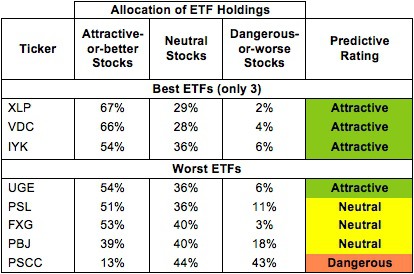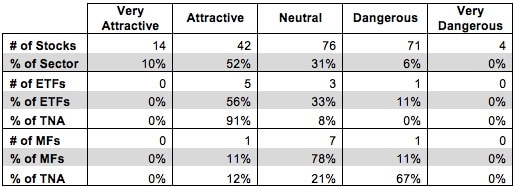The Consumer Staples sector ranks first out of the ten sectors as detailed in my Sector Rankings for ETFs and Mutual Funds report. It gets my Attractive rating, which is based on aggregation of ratings of nine ETFs and nine mutual funds in the Consumer Staples sector as of April 16, 2013. Prior reports on the best & worst ETFs and mutual funds in every sector and style are here.
Figures 1 and 2 rank all eight ETFs and all 8 mutual funds in the sector that meet our liquidity standards. Not all Consumer Staples sector ETFs and mutual funds are created the same. The number of holdings varies widely (from 22 to 119), which creates drastically different investment implications and ratings. The best ETFs and mutual funds allocate more value to Attractive-or-better-rated stocks than the worst ETFs and mutual funds, which allocate too much value to Neutral-or-worse-rated stocks.
To identify the best and avoid the worst ETFs and mutual funds within the Consumer Staples sector, investors need a predictive rating based on (1) stocks ratings of the holdings and (2) the all-in expensesof each ETF and mutual fund. Investors need not rely on backward-looking ratings. My fund rating methodology is detailed here.
Investors seeking exposure to the Consumer Staples sector should buy one of the Attractive-or-better rated ETFs or mutual funds from Figures 1 and 2.
Get my ratings on all ETFs and mutual funds in this sector on my free mutual fund and ETF screener.
Figure 1: ETFs with the Best & Worst Ratings – Top 5
* Best ETFs exclude ETFs with TNAs less than $100 million for inadequate liquidity.
Sources: New Constructs, LLC and company filings
Guggenheim S&P Equal Weight Consumer Staples ETF (RHS) is excluded from Figure 1 because its total net assets (TNA) are below $100 million and do not meet our liquidity standards.
Figure 2: Mutual Funds with the Best & Worst Ratings – Top 5
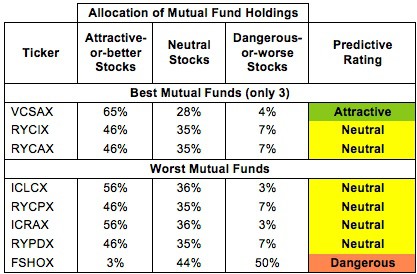 * Best mutual funds exclude funds with TNAs less than $100 million for inadequate liquidity
* Best mutual funds exclude funds with TNAs less than $100 million for inadequate liquidity
Sources: New Constructs, LLC and company filings
ICON Consumer Staples Fund (ICLEX) is excluded from Figure 2 because its total net assets (TNA) are below $100 million and do not meet our liquidity standards.
Consumer Staples Select Sector SPDR (XLP) is my top-rated Consumer Staples ETF and Vanguard Consumer Staples Index Fund (VCSAX) is my top-rated Consumer Staples mutual fund. Both earn my Attractive rating.
PowerShares S&P SmallCap Consumer Staples Portfolio (PSCC) is my worst-rated Consumer Staples ETF and Fidelity Select Portfolios: Construction & Housing Portfolio (FSHOX) is my worst-rated Consumer Staples mutual fund. Both earn my Dangerous rating.
Figure 3 shows that 56 out of the 207 stocks (over 62% of the market value) in Consumer Staples ETFs and mutual funds get an Attractive-or-better rating. 91% of assets in Consumer Staples ETFs are in Attractive rated funds. However, only 12% of assets in Consumer Staples mutual funds make it into an Attractive-rated fund. ETF investors allocate capital to good funds much better than the mutual fund investors. I wonder if that is because most ETF investors are self-directed while many mutual fund investors are following advice. It also helps that there are more Attractive ETFs to choose from.
Figure 3: Consumer Staples Sector Landscape For ETFs, Mutual Funds & Stocks
As detailed in “Cheap Funds Dupe Investors”, the fund industry offers many cheap funds but very few funds with high-quality stocks, or with what I call good portfolio management.Sources: New Constructs, LLC and company filings
Investors need to tread carefully when considering Consumer Staples ETFs and mutual funds, as the sector’s Attractive rating does not mean every fund is attractive. Only five ETFs and one mutual fund in the Consumer Staples sector allocate enough value to Attractive-or-better-rated stocks to earn an Attractive rating.
The Coca-Cola Company (KO) is one of my favorite stocks held by Consumer Staples ETFs and mutual funds and earns my Attractive rating. The soft drink industry has long been a profitable one. There are relatively few competitors and low production costs keep margins high. KO remains the leader in this industry and continues to outperform its peers. Its return on invested capital (ROIC) of 14% last year was nearly double that of PepsiCo (PEP). Over the past 13 years it has grown after-tax profit (NOPAT) by 10% compounded annually. Despite this strong track record, KO is valued at only ~$40.09/share, giving it aprice to economic book value ratio of 1.1. This implies that the market expects KO’s NOPAT to never go more than 10% above its present level. Such a low market expectation makes this stock a low risk high reward prospect for investors.
TreeHouse Foods, Inc. (THS) is one of my least favorite stocks held by Consumer Staples ETFs and mutual funds and earns my Dangerous rating. THS has not earned positive economic earnings since it was formed in 2005. The company also carries over $1 billion in debt. We find another over $275 million in liabilities buried in the footnotes. The stock’s valuation suggests the market assumes this stock is as safe as other Consumer Staples stocks. The share price is already up over 19% in 2013 to ~$62.11/share. To justify this valuation, THS would need to grow NOPAT by 6.5% compounded annually for 18 years. Such high expectations make just about any stock risky, no matter what sector it’s in.
121 stocks of the 3000+ I cover are classified as Consumer Staples stocks, but due to style drift, Consumer Staples ETFs and mutual funds hold 207 stocks.
Figures 4 and 5 show the rating landscape of all Consumer Staples ETFs and mutual funds.
My Sector Rankings for ETFs and Mutual Funds report ranks all sectors and highlights those that offer the best investments.
Figure 4: Separating the Best ETFs From the Worst ETFs
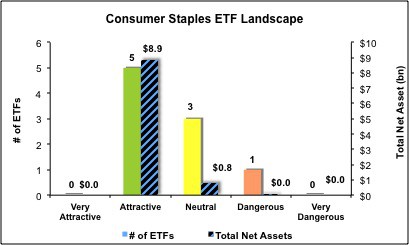 Sources: New Constructs, LLC and company filings
Sources: New Constructs, LLC and company filings
Figure 5: Separating the Best Mutual Funds From the Worst Mutual Funds
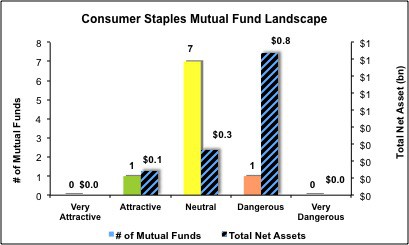 Sources: New Constructs, LLC and company filings
Sources: New Constructs, LLC and company filings
Review my full list of ratings and rankings along with reports on all nine ETFs and nine mutual funds in the Consumer Staples sector.
Sam McBride contributed to this report
Disclosure: David Trainer and Sam McBride receive no compensation to write about any specific stock, sector, or theme.

